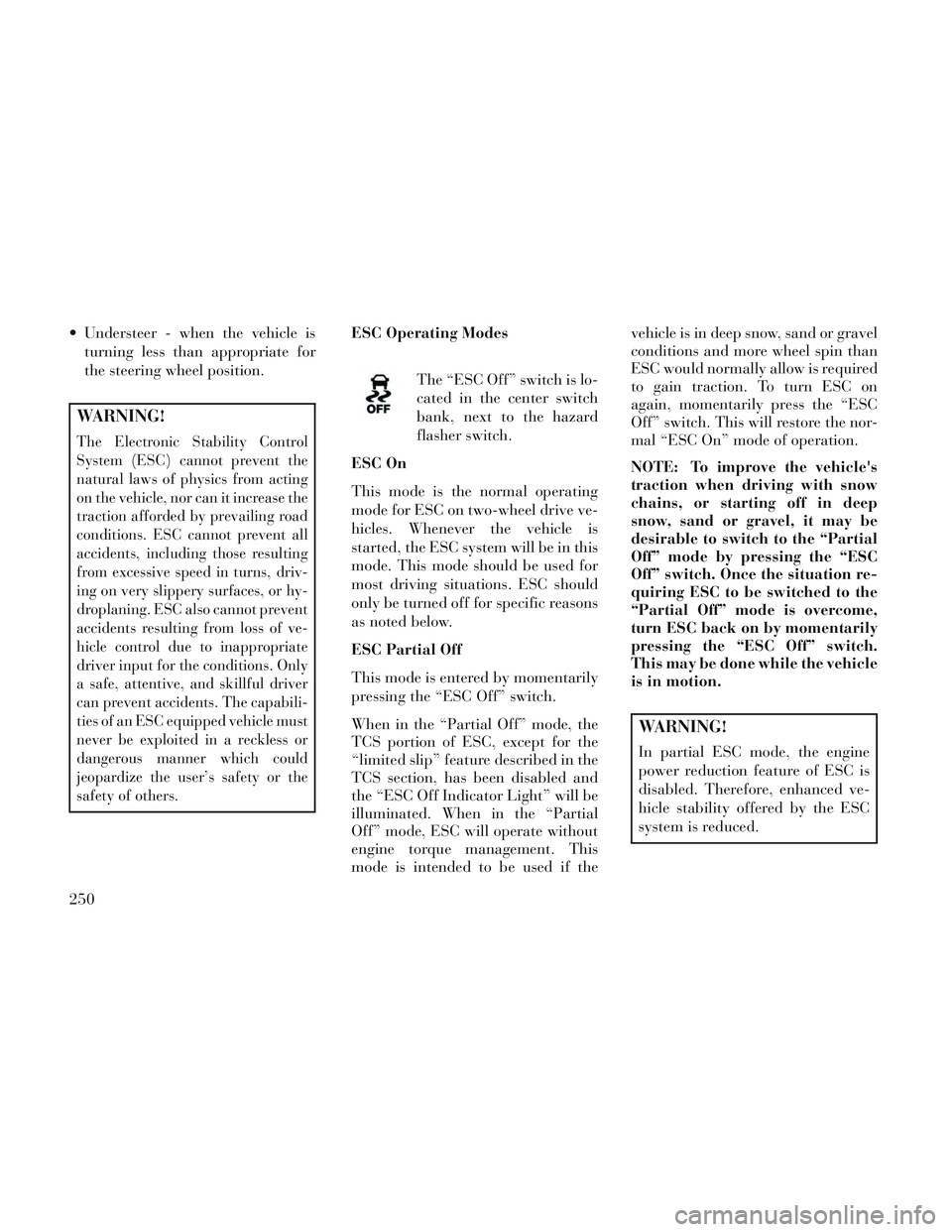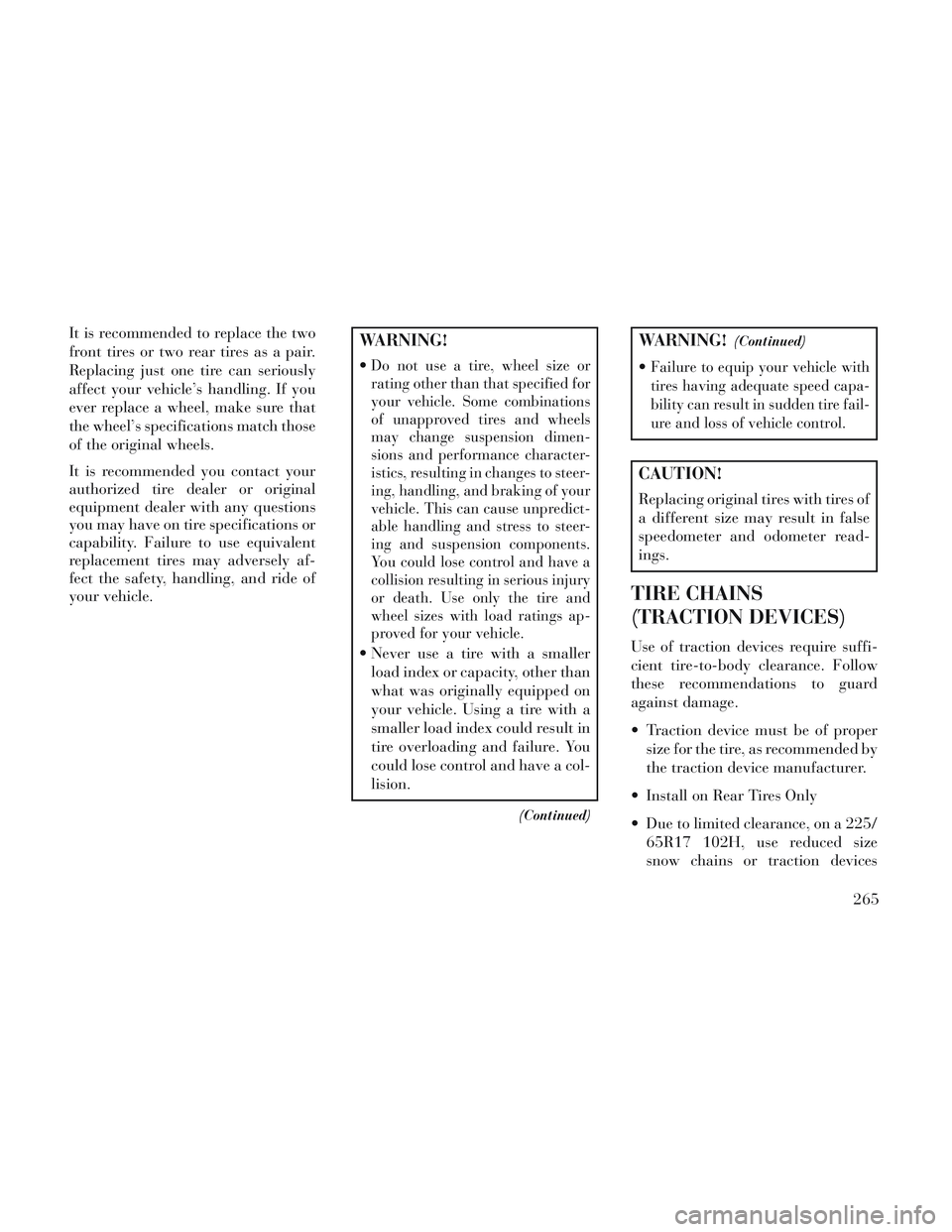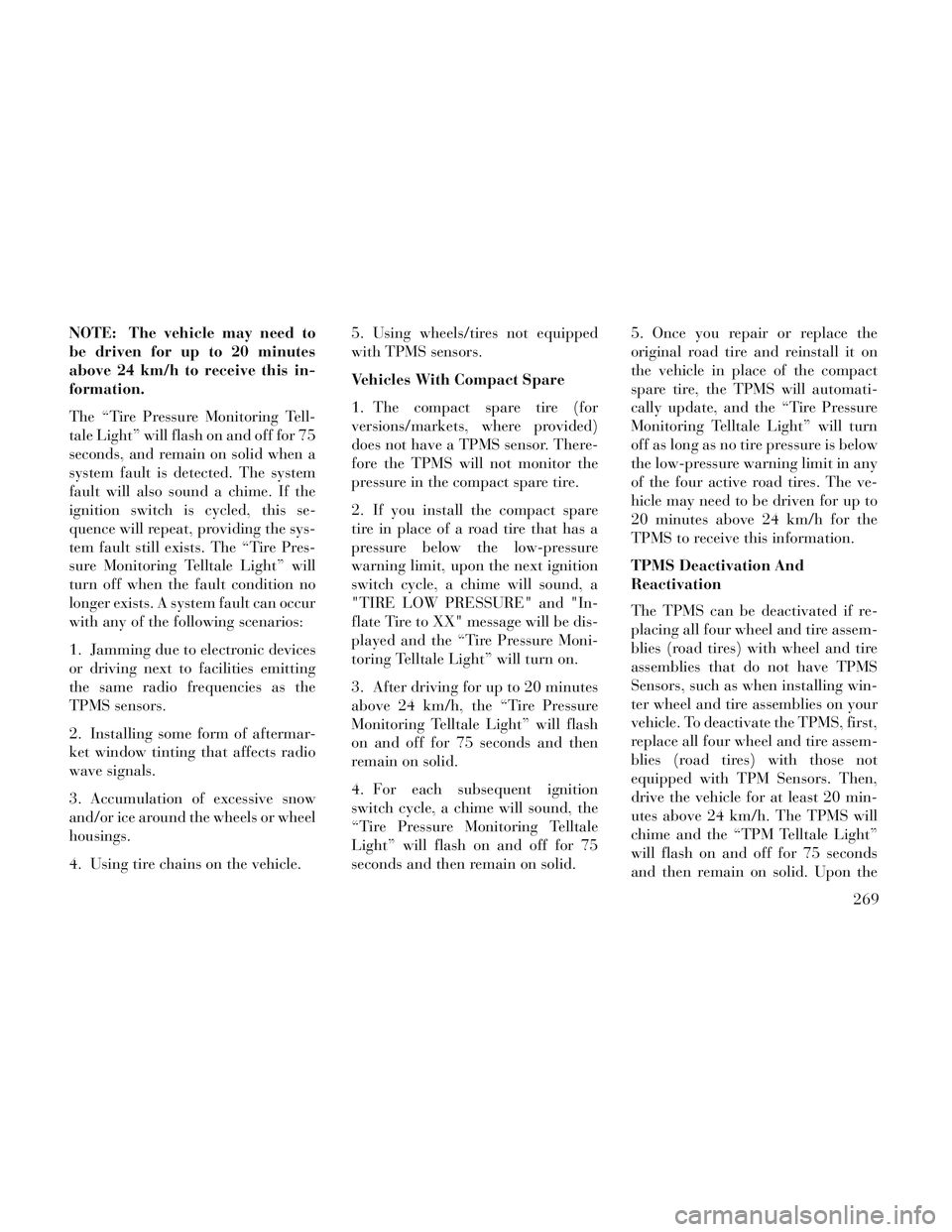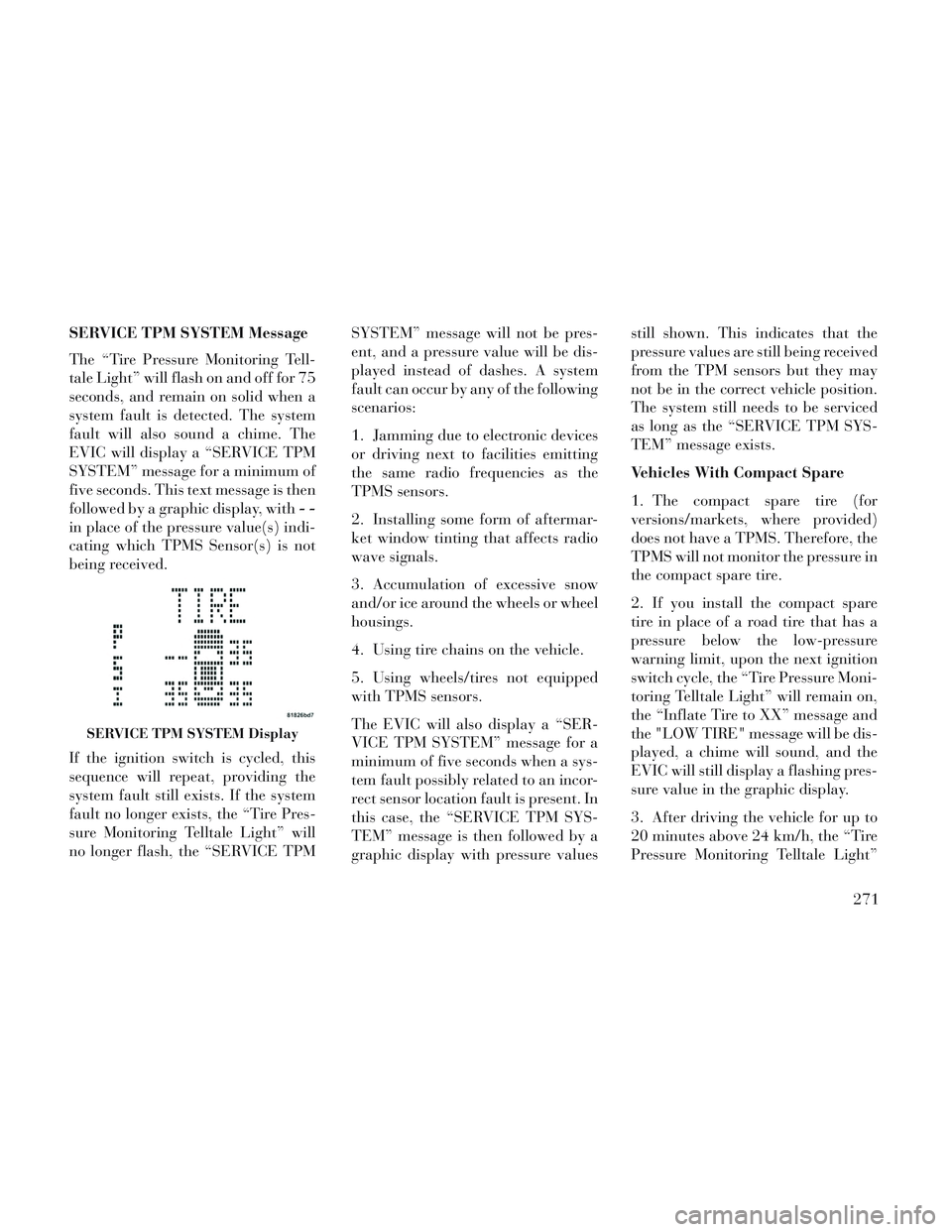snow chains Lancia Voyager 2014 Owner handbook (in English)
[x] Cancel search | Manufacturer: LANCIA, Model Year: 2014, Model line: Voyager, Model: Lancia Voyager 2014Pages: 364, PDF Size: 3.49 MB
Page 256 of 364

Understeer - when the vehicle isturning less than appropriate for
the steering wheel position.
WARNING!
The Electronic Stability Control
System (ESC) cannot prevent the
natural laws of physics from acting
on the vehicle, nor can it increase the
traction afforded by prevailing road
conditions. ESC cannot prevent all
accidents, including those resulting
from excessive speed in turns, driv-
ing on very slippery surfaces, or hy-
droplaning. ESC also cannot prevent
accidents resulting from loss of ve-
hicle control due to inappropriate
driver input for the conditions. Only
a safe, attentive, and skillful driver
can prevent accidents. The capabili-
ties of an ESC equipped vehicle must
never be exploited in a reckless or
dangerous manner which could
jeopardize the user’s safety or the
safety of others.
ESC Operating Modes
The “ESC Off” switch is lo-
cated in the center switch
bank, next to the hazard
flasher switch.
ESC On
This mode is the normal operating
mode for ESC on two-wheel drive ve-
hicles. Whenever the vehicle is
started, the ESC system will be in this
mode. This mode should be used for
most driving situations. ESC should
only be turned off for specific reasons
as noted below.
ESC Partial Off
This mode is entered by momentarily
pressing the “ESC Off” switch.
When in the “Partial Off” mode, the
TCS portion of ESC, except for the
“limited slip” feature described in the
TCS section, has been disabled and
the “ESC Off Indicator Light” will be
illuminated. When in the “Partial
Off” mode, ESC will operate without
engine torque management. This
mode is intended to be used if the vehicle is in deep snow, sand or gravel
conditions and more wheel spin than
ESC would normally allow is required
to gain traction. To turn ESC on
again, momentarily press the “ESC
Off” switch. This will restore the nor-
mal “ESC On” mode of operation.
NOTE: To improve the vehicle's
traction when driving with snow
chains, or starting off in deep
snow, sand or gravel, it may be
desirable to switch to the “Partial
Off” mode by pressing the “ESC
Off” switch. Once the situation re-
quiring ESC to be switched to the
“Partial Off” mode is overcome,
turn ESC back on by momentarily
pressing the “ESC Off” switch.
This may be done while the vehicle
is in motion.
WARNING!
In partial ESC mode, the engine
power reduction feature of ESC is
disabled. Therefore, enhanced ve-
hicle stability offered by the ESC
system is reduced.
250
Page 271 of 364

It is recommended to replace the two
front tires or two rear tires as a pair.
Replacing just one tire can seriously
affect your vehicle’s handling. If you
ever replace a wheel, make sure that
the wheel’s specifications match those
of the original wheels.
It is recommended you contact your
authorized tire dealer or original
equipment dealer with any questions
you may have on tire specifications or
capability. Failure to use equivalent
replacement tires may adversely af-
fect the safety, handling, and ride of
your vehicle.WARNING!
Do not use a tire, wheel size or
rating other than that specified for
your vehicle. Some combinations
of unapproved tires and wheels
may change suspension dimen-
sions and performance character-
istics, resulting in changes to steer-
ing, handling, and braking of your
vehicle. This can cause unpredict-
able handling and stress to steer-
ing and suspension components.
You could lose control and have a
collision resulting in serious injury
or death. Use only the tire and
wheel sizes with load ratings ap-
proved for your vehicle.
Never use a tire with a smallerload index or capacity, other than
what was originally equipped on
your vehicle. Using a tire with a
smaller load index could result in
tire overloading and failure. You
could lose control and have a col-
lision.
(Continued)
WARNING!(Continued)
Failure to equip your vehicle with
tires having adequate speed capa-
bility can result in sudden tire fail-
ure and loss of vehicle control.
CAUTION!
Replacing original tires with tires of
a different size may result in false
speedometer and odometer read-
ings.
TIRE CHAINS
(TRACTION DEVICES)
Use of traction devices require suffi-
cient tire-to-body clearance. Follow
these recommendations to guard
against damage.
Traction device must be of proper size for the tire, as recommended by
the traction device manufacturer.
Install on Rear Tires Only
Due to limited clearance, on a 225/ 65R17 102H, use reduced size
snow chains or traction devices
265
Page 275 of 364

NOTE: The vehicle may need to
be driven for up to 20 minutes
above 24 km/h to receive this in-
formation.
The “Tire Pressure Monitoring Tell-
tale Light” will flash on and off for 75
seconds, and remain on solid when a
system fault is detected. The system
fault will also sound a chime. If the
ignition switch is cycled, this se-
quence will repeat, providing the sys-
tem fault still exists. The “Tire Pres-
sure Monitoring Telltale Light” will
turn off when the fault condition no
longer exists. A system fault can occur
with any of the following scenarios:
1. Jamming due to electronic devices
or driving next to facilities emitting
the same radio frequencies as the
TPMS sensors.
2. Installing some form of aftermar-
ket window tinting that affects radio
wave signals.
3. Accumulation of excessive snow
and/or ice around the wheels or wheel
housings.
4. Using tire chains on the vehicle.5. Using wheels/tires not equipped
with TPMS sensors.
Vehicles With Compact Spare
1. The compact spare tire (for
versions/markets, where provided)
does not have a TPMS sensor. There-
fore the TPMS will not monitor the
pressure in the compact spare tire.
2. If you install the compact spare
tire in place of a road tire that has a
pressure below the low-pressure
warning limit, upon the next ignition
switch cycle, a chime will sound, a
"TIRE LOW PRESSURE" and "In-
flate Tire to XX" message will be dis-
played and the “Tire Pressure Moni-
toring Telltale Light” will turn on.
3. After driving for up to 20 minutes
above 24 km/h, the “Tire Pressure
Monitoring Telltale Light” will flash
on and off for 75 seconds and then
remain on solid.
4. For each subsequent ignition
switch cycle, a chime will sound, the
“Tire Pressure Monitoring Telltale
Light” will flash on and off for 75
seconds and then remain on solid.5. Once you repair or replace the
original road tire and reinstall it on
the vehicle in place of the compact
spare tire, the TPMS will automati-
cally update, and the “Tire Pressure
Monitoring Telltale Light” will turn
off as long as no tire pressure is below
the low-pressure warning limit in any
of the four active road tires. The ve-
hicle may need to be driven for up to
20 minutes above 24 km/h for the
TPMS to receive this information.
TPMS Deactivation And
Reactivation
The TPMS can be deactivated if re-
placing all four wheel and tire assem-
blies (road tires) with wheel and tire
assemblies that do not have TPMS
Sensors, such as when installing win-
ter wheel and tire assemblies on your
vehicle. To deactivate the TPMS, first,
replace all four wheel and tire assem-
blies (road tires) with those not
equipped with TPM Sensors. Then,
drive the vehicle for at least 20 min-
utes above 24 km/h. The TPMS will
chime and the “TPM Telltale Light”
will flash on and off for 75 seconds
and then remain on solid. Upon the
269
Page 277 of 364

SERVICE TPM SYSTEM Message
The “Tire Pressure Monitoring Tell-
tale Light” will flash on and off for 75
seconds, and remain on solid when a
system fault is detected. The system
fault will also sound a chime. The
EVIC will display a “SERVICE TPM
SYSTEM” message for a minimum of
five seconds. This text message is then
followed by a graphic display, with--
in place of the pressure value(s) indi-
cating which TPMS Sensor(s) is not
being received.
If the ignition switch is cycled, this
sequence will repeat, providing the
system fault still exists. If the system
fault no longer exists, the “Tire Pres-
sure Monitoring Telltale Light” will
no longer flash, the “SERVICE TPM SYSTEM” message will not be pres-
ent, and a pressure value will be dis-
played instead of dashes. A system
fault can occur by any of the following
scenarios:
1. Jamming due to electronic devices
or driving next to facilities emitting
the same radio frequencies as the
TPMS sensors.
2. Installing some form of aftermar-
ket window tinting that affects radio
wave signals.
3. Accumulation of excessive snow
and/or ice around the wheels or wheel
housings.
4. Using tire chains on the vehicle.
5. Using wheels/tires not equipped
with TPMS sensors.
The EVIC will also display a “SER-
VICE TPM SYSTEM” message for a
minimum of five seconds when a sys-
tem fault possibly related to an incor-
rect sensor location fault is present. In
this case, the “SERVICE TPM SYS-
TEM” message is then followed by a
graphic display with pressure valuesstill shown. This indicates that the
pressure values are still being received
from the TPM sensors but they may
not be in the correct vehicle position.
The system still needs to be serviced
as long as the “SERVICE TPM SYS-
TEM” message exists.
Vehicles With Compact Spare
1. The compact spare tire (for
versions/markets, where provided)
does not have a TPMS. Therefore, the
TPMS will not monitor the pressure in
the compact spare tire.
2. If you install the compact spare
tire in place of a road tire that has a
pressure below the low-pressure
warning limit, upon the next ignition
switch cycle, the “Tire Pressure Moni-
toring Telltale Light” will remain on,
the “Inflate Tire to XX” message and
the "LOW TIRE" message will be dis-
played, a chime will sound, and the
EVIC will still display a flashing pres-
sure value in the graphic display.
3. After driving the vehicle for up to
20 minutes above 24 km/h, the “Tire
Pressure Monitoring Telltale Light”
SERVICE TPM SYSTEM Display
271
Page 360 of 364

Rear Seat................36
Seats....................111
Adjustment..........111, 114
Fold in Floor (Stow `n Go). . .117
Heated................113
Memory................125
Power.................111
Reclining...............115
Stow `n Go (Fold in Floor). . .117
Security Alarm (Theft Alarm)....16
Selection of Coolant
(Antifreeze)
..........316, 334
Sentry Key (Immobilizer).......15
Sentry Key Programming.......16
Sentry Key Replacement........16
Service Engine Soon Light(Malfunction Indicator)
......174
Settings, Personal............189
Shift Lever Override..........300
Shoulder Belts...............36
Side Airbag.................52
Side Repeater Lights..........332
Signals, Turn.......71, 131, 172,
331, 332
Sliding Door................29
SmartBeams.............. .132
Snow Chains (Tire Chains).....265
Snow Tires................261
Sound Systems..............193
Sound Systems (Radio)........193
Spare Tire.........262, 263, 288
Spark Plugs................334
Specifications
Fuel (Gasoline)
...........334
Oil.................. .334
Speed Control (Cruise Control). . .136
Speedometer...............176
Starting................. .231
Automatic Transmission.....231
Cold Weather............233
Engine Fails to Start.......233
Starting and Operating........231
Starting Procedures..........231
Starting Procedures (Diesel
Engines)
................234
SteeringPower
.............244, 245
Tilt Column.............135
Wheel Lock..............15
Wheel, Tilt............. .135
Steering Wheel Audio Controls. . .217
Steering Wheel Mounted Sound
System Controls
...........217
Storage.................. .330
Storage Bin................153
Storage, Vehicle.........225, 330
Storing Your Vehicle..........330
Stow `n Go (Fold in Floor) Seats. .117
Sunglasses Storage...........145
Supplemental Restraint System -
Airbag
..................46
Sway Control, Trailer.........251
Synthetic Engine Oil..........309
System, Navigation(Uconnect® gps)
...........193
Tachometer................172
Telescoping Steering Column. . . .135
Temperature Control, Automatic(ATC)
..................219
Temperature Gauge, EngineCoolant
.............178, 286
Tilt Steering Column..........135
Tire and Loading InformationPlacard
.................256
Tire Markings............. .252
Tires..................71, 258
Aging (Life of Tires).......264
Air Pressure.............258
Chains.................265
Changing.............. .287
Compact Spare...........262
General Information.......258
High Speed.............260
Inflation Pressures.........259
Jacking............287, 291
Life of Tires.............264
354